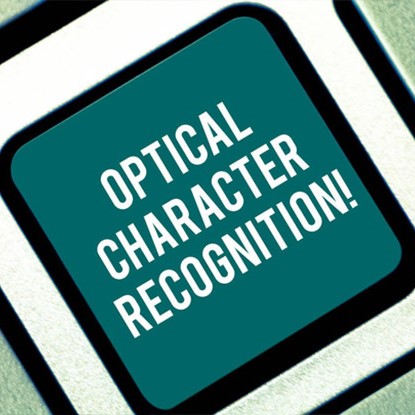OCR in Document Processing:
Workflows, Software, Applications
Discover how organizations can simplify their document processing workflows, improve accuracy, and enhance overall operational efficiency.

Discover how organizations can simplify their document processing workflows, improve accuracy, and enhance overall operational efficiency.

OCR (Optical Character Recognition) has emerged as a game-changer in document processing, unlocking unprecedented efficiency and accuracy across various industries. In fact, OCR has revolutionized document processing, driving efficiency, accuracy, and accessibility across various industries.
By harnessing OCR power, organizations can significantly streamline workflows, improve customer experiences, reduce costs, and gain a competitive edge in a data-driven world. In this article, we discover how OCR helps streamline document processing workflows.

Streamline your document processing workflows and boost efficiency with our advanced OCR technology. Experience the power of automated data extraction, seamless integration, and accelerated processing. Say goodbye to manual entry and hello to a more productive future!
Document processing is an essential aspect of business operations, but it comes with its fair share of challenges. Here are some common challenges faced in document processing:
The reliance on manual data entry is time-consuming and prone to errors. Extracting information from physical documents or unstructured formats can lead to inaccuracies and hinder operational efficiency.
Documents come in various formats, styles, and layouts. Dealing with this variability can be challenging, as traditional systems may struggle to accurately interpret and process information from diverse document structures.
Many organizations still operate with paper-based or outdated digital workflows. This can result in inefficient processes, delays, and difficulties in tracking the status of documents throughout their lifecycle.
RELATED: Data Extraction with OCR: Extracting Data from Invoices
The absence of automation in document processing leads to a slower turnaround time. Without automated tools, organizations may find it challenging to keep up with the volume of incoming documents, leading to bottlenecks.
Ensuring the security and confidentiality of sensitive information is a paramount concern. Document processing systems must adhere to strict security standards to protect against data breaches and unauthorized access.
Integrating document processing systems with existing workflows and software can be complex. Incompatibility issues may arise, hindering the seamless flow of information between different platforms.

As organizations grow, the volume of documents typically increases. Legacy systems may struggle to scale, leading to performance issues and a lack of adaptability to the evolving needs of the business.
Meeting compliance standards and adhering to regulatory requirements is crucial. Document processing systems must ensure that they handle information in a manner that aligns with industry-specific regulations.
Without proper tracking and monitoring mechanisms, organizations may lack visibility into the status and location of documents in their workflow. This can result in delays and difficulties in addressing issues promptly.
Resistance to adopting new technologies can impede the implementation of advanced document processing solutions. Overcoming this barrier requires effective change management and training programs.
Addressing these challenges often involves the adoption of advanced technologies, such as Optical Character Recognition (OCR), workflow automation, and secure document management systems.
Revolutionize Your Document Workflows!
Artsyl docAlpha is your key to revolutionizing document management. Harness the capabilities of OCR to transform paper-based documents into digital assets. Automate data entry, enhance accuracy, and navigate your workflows with unprecedented ease.
Book a demo now
OCR is a technology that enables computers to read and understand text embedded within images or scanned documents. It acts as a bridge between the physical world of printed or handwritten documents and the digital realm of text-based data. Here’s how it works:
Common applications of OCR include converting physical documents into searchable electronic files, creating searchable digital archives of historical documents and facilitating text translation in various languages. OCR also helps automating data extraction from forms, invoices, receipts, and other documents.
RELATED: OCR: What Optical Character Recognition Is?
Another exciting application is text-to-speech conversion: Making printed text accessible to people with visual impairments. Here’s a closer look at how OCR simplifies workflows and transforms document-centric processes.
Experience the OCR Advantage with Artsyl!
Discover the game-changing benefits of Artsyl docAlpha’s OCR capabilities. From improved accuracy to faster processing, our solution empowers you to conquer document challenges effortlessly. Take the leap towards a simplified document processing journey.
Book a demo now
OCR (Optical Character Recognition) plays a pivotal role in simplifying workflows and transforming document-centric processes. Here’s how:
OCR automates the extraction of text and data from scanned documents, eliminating the need for manual data entry. This significantly accelerates document processing times, enabling tasks that once took hours to be completed in minutes.
By automating routine tasks, OCR technology allows professionals to focus on more strategic and value-added activities.
Manual data entry is prone to errors, leading to inaccuracies in document processing. OCR technology, with its high accuracy in recognizing and extracting text, minimizes the risk of errors associated with human data entry.
This not only enhances the reliability of information but also reduces the time and resources spent on error correction.
OCR transforms static documents into searchable and editable formats. This makes it easier to locate specific information within large volumes of documents, fostering quick decision-making and retrieval.
Moreover, the ability to convert scanned text into accessible formats promotes inclusivity and facilitates document sharing across diverse platforms.
OCR software v facilitates the digitization of documents, breaking down the barriers associated with physical paperwork. Digitized and searchable documents empower teams to collaborate seamlessly, regardless of geographical locations. This not only improves communication but also enables a more agile and efficient workflow.
OCR technologies are designed to integrate seamlessly with existing document management and workflow systems. This ensures a smooth transition without disrupting established processes. The compatibility of OCR with various platforms allows organizations to leverage its benefits without overhauling their current infrastructure.
RELATED: OCR Image to Text Conversion: What is It?
By automating document processing and reducing the need for manual intervention, OCR contributes to significant cost savings. Organizations can allocate resources more efficiently, redirecting human efforts towards strategic initiatives.
The reduction in manual errors also results in financial savings associated with error correction and compliance.
OCR enhances compliance by ensuring accurate and consistent handling of information. Automated data extraction and processing reduce the risk of non-compliance with regulatory standards.
Additionally, OCR technologies often come equipped with robust security features to safeguard sensitive data, ensuring the integrity and confidentiality of documents.
Accelerate Your Business with Artsyl docAlpha OCR!
Speed up your business processes and drive success with Artsyl docAlpha OCR. Unleash the potential of automated data extraction, reducing manual efforts and errors. Embrace the future of document processing and witness the transformation in your workflow speed.
Book a demo now
Optical Character Recognition (OCR) technology finds diverse applications across various industries, bringing efficiency and accuracy to document processing. Here are some notable applications of OCR in different sectors:

Contact Us for an in-depth
product tour!
The versatility of OCR technology continues to drive innovation across industries, offering solutions to streamline document-centric processes and improve overall operational efficiency.
Effortless Document Processing Starts Here!
Artsyl docAlpha makes document processing a breeze. Let OCR do the heavy lifting for you – automate, extract, and manage your documents effortlessly. Elevate your productivity, minimize errors, and experience a new era of streamlined business operations.
Book a demo now
OCR (Optical Character Recognition) is a technology that enables the conversion of various document types, including scanned images or printed text, into machine-readable and editable formats. OCR involves recognizing and interpreting characters, words, and layouts within documents, allowing for efficient digitalization and extraction of textual information.
OCR works by using pattern recognition algorithms to analyze images of text and identify characters. The process involves several key steps, including image capture, pre-processing to enhance image quality, segmentation to identify individual characters or words, feature extraction to analyze patterns, and recognition to convert the identified patterns into machine-readable text. The result is an accurate and editable digital representation of the original document’s content.
Document processing automation involves utilizing technology to streamline and accelerate the handling of documents within a workflow. This includes automating tasks like sorting, routing, and extracting data from documents, reducing manual effort and enhancing efficiency.

Document digitization solutions refer to technologies and processes that convert physical documents into digital formats. These solutions often involve scanning, optical character recognition (OCR), and data extraction methods, facilitating easier storage, retrieval, and management of information.
RELATED: AI-Powered Invoice Data Extraction: Beyond OCR
Popular OCR tools employ advanced data extraction techniques to analyze images of text and convert them into machine-readable formats. These techniques include pattern recognition algorithms and feature extraction to accurately interpret and extract textual information from various document types.
Document workflow management encompasses the design, execution, and optimization of processes related to document handling within an organization. It involves organizing tasks, defining responsibilities, and implementing technology to ensure efficient movement and processing of documents through different stages.
OCR implementation involves integrating Optical Character Recognition technology into existing systems or workflows. This enables the automatic recognition and extraction of text from scanned documents, improving searchability and accessibility of content.
Automating data entry with OCR involves using Optical Character Recognition to automatically input data from documents into digital systems. This not only accelerates the data entry process but also minimizes errors associated with manual entry, enhancing accuracy and efficiency.
As you can see, OCR simplifies workflows by automating tedious tasks, improving accuracy, enabling efficient collaboration, and promoting cost savings. Its transformative impact on document-centric processes is evident in the streamlined and agile workflows it facilitates across various industries.
Say Hello to Precision with OCR!
Precision meets efficiency with Artsyl docAlpha. Our OCR technology ensures accurate data extraction, enabling you to take control of your document processing. Embrace the future of precision and efficiency – say hello to Artsyl docAlpha today!
Book a demo now
OCR, or Optical Character Recognition, is a technology that converts different document types, like scanned images or printed text, into machine-readable formats. It enhances document processing by automating tasks, reducing errors, and improving the overall efficiency of handling textual information.
OCR simplifies workflows by automating the extraction of text from documents, eliminating the need for manual data entry. This streamlines tasks such as data extraction, document searchability, and overall document digitization, making processes more efficient.
OCR technology offers benefits such as enhanced efficiency, accuracy, and searchability. It accelerates document processing, reduces errors associated with manual entry, and allows for the quick retrieval of information from digitized documents.
Yes, OCR can be seamlessly integrated into existing document workflows. Its compatibility with various platforms allows organizations to enhance their document processing without the need for a complete overhaul of their current systems.
OCR is applied across various industries, including finance, healthcare, legal, logistics, education, retail, and more. Its versatility makes it a valuable tool for any sector that deals with document-centric processes.

OCR contributes to data security by ensuring accurate and consistent handling of information. Automated data extraction reduces the risk of errors and enhances compliance with regulatory standards, promoting a secure document processing environment.
Yes, OCR technology has advanced capabilities to recognize and extract text from handwritten documents. This enables the digitization of various types of documents, enhancing accessibility and searchability.
Considerations include the accuracy of the OCR tool, integration with existing systems, security features, and scalability. It’s essential to choose a solution that aligns with the specific needs and requirements of the organization.
OCR automates data entry by extracting information from documents and inputting it into digital systems. This reduces manual effort, accelerates the data entry process, and minimizes errors associated with manual input.
Yes, OCR is a cost-effective solution. By automating tasks, reducing errors, and improving efficiency, organizations can experience cost savings associated with time, resources, and error correction in document processing workflows.
I. Integration of OCR into Workflows
II. Challenges and Considerations
III. Future Trends in OCR Technology
